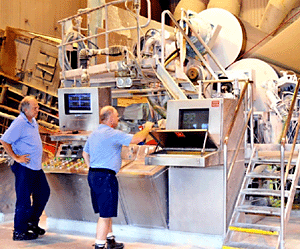Catalyst Paper's Port Alberni Mill Faces Growing Shortage of Skilled Labor
 Print this article | Send to Colleague Print this article | Send to Colleague
 The Catalyst Paper mill in Port Alberni, B.C., Canada, foresees a labor shortage looming on the horizon. Fred Chinn, general manager at the mill, said in an Alberni Valley Times article this past week that the company and mill are coming out the other side of their bankruptcy issues and will be stronger than ever, but first they have to figure out how to replace the skilled employees who are retiring on a regular basis from the Port Alberni operation. The Catalyst Paper mill in Port Alberni, B.C., Canada, foresees a labor shortage looming on the horizon. Fred Chinn, general manager at the mill, said in an Alberni Valley Times article this past week that the company and mill are coming out the other side of their bankruptcy issues and will be stronger than ever, but first they have to figure out how to replace the skilled employees who are retiring on a regular basis from the Port Alberni operation.
"We have to educate people on the possibilities," Chinn explained. "There are lots of jobs here that people don't even know about." He said that in the past 18 months the paper mill has hired 60 workers, most of those to replace retiring employees.
Chinn further noted in the article that when the layoffs hit in the 1990s, many of the younger workers were the first to go because they did not have enough seniority to keep their jobs. That left the mill with a workforce that consisted of mostly men of similar ages and experience levels. Now, a lot of those employees have put in more than 30 years with the company, and they are ready to retire.
Catalyst is now having a difficult time attracting young skilled workers. "We are trying to encourage youth to chase jobs that are available here," Chinn said. "It allows them to stay in the Valley."
But the lure of high-paying positions in Alberta is hard to compete with, especially after coming out of the financial challenges Catalyst has faced in the past couple of years. But some people, the article noted, see the opportunity that lies within their hometown.
Richard Martell, for example, was hired at the paper mill a year ago. He had worked in the paper industry before, but most recently was commuting over the Hump to work in health care. Working on the paper machine at Catalyst means he can stay close to his family."For me it's about family," he said. "I want to be close to them. It's a lifestyle choice, and I want to be here." He said that opportunities have come up in the past in Alberta, and he can understand the temptation of the money that can be made in camp-style jobs. But he said it always came back to priorities. His is being close to his wife and children.
In about a month, the article continues, Richard Van Herwaarden, will retire from a career that has challenged him for more than three decades. He is a maintenance carpenter, and he said the company offered him a great career, one he would recommend to anyone. But he has also seen a lot change in his time at the mill. "When I first started in the trades in 1980 it was like a small city here," he said. "There were tradesmen everywhere. People made their careers here after the war. The workload has decreased, but we need people here, and it will always offer a fulfilling career."
Van Herwaarden said the mill employed approximately 1,500 people back then, a number that has shrunk to around 340 in recent years.
Finding a way to attract workers is one of the most challenging aspects of Chinn's job. He said it is important that people understand the mill might not offer as many jobs as it once did, but there are still lots of opportunities. One way to attract young workers is to host an open house for educators. In the near future, they hope to invite staff from the high school in to tour the mill and learn what opportunities exist in Port Alberni. He said more people have to consider the trades as a great option. One way they can promote that is by offering more opportunities for apprenticing at the mill.
The Port Alberni mill operates two paper machines with a total capacity of 340,000 metric tpy, split between coated papers (224,000 metric tpy) and directory paper (116,000 metric tpy). In the photo, Gary Knutson (l) and David Best monitor paper machine coater operations at the mill.
|
|

